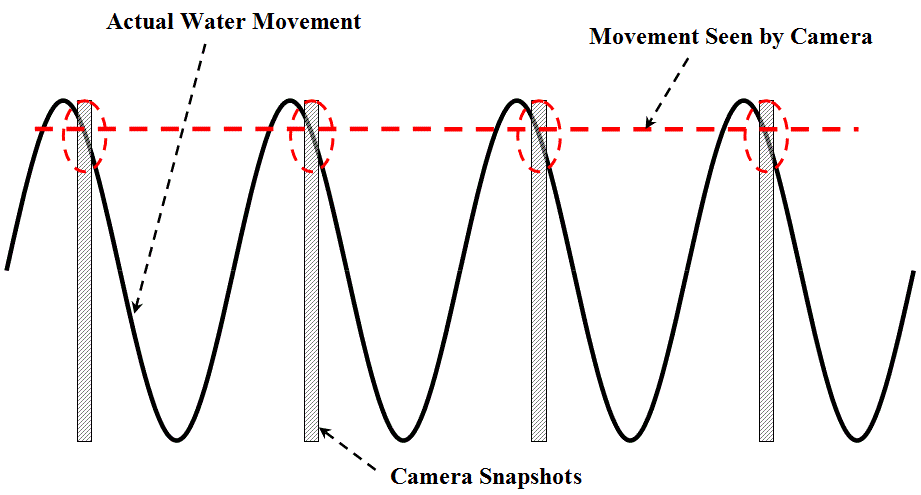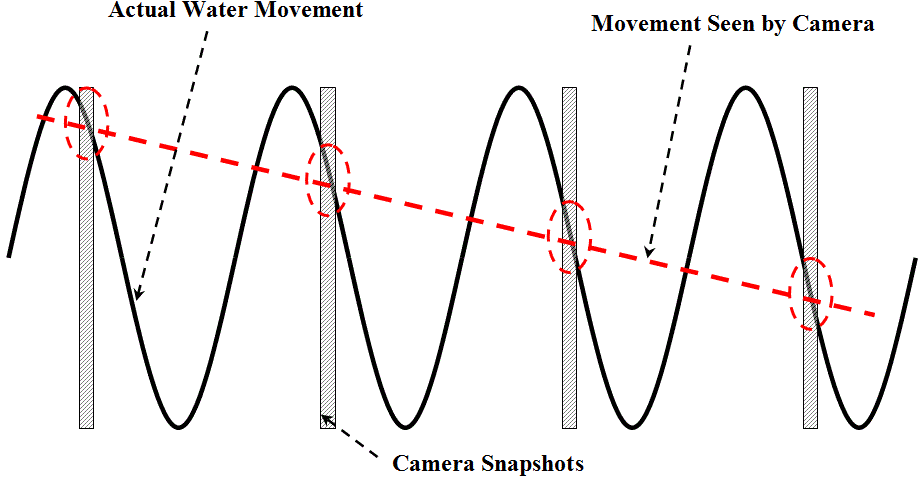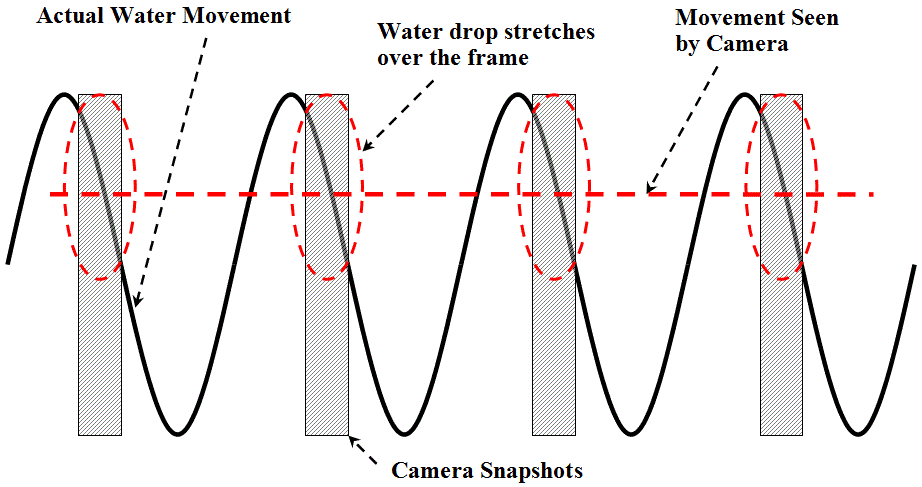Who knew a vibrator could cause levitation? Here’s the proof:
It’s quite amazing the sight of the levitating water. The problem is that it is the camera that records the water like this and it is not visible to a human eye.
The flow of water has a randomness to it, but vibrating with a uniform wave will give it a very predictable shape. If the flow of the falling water is vibrated at the same frame rate as the camera, then you will see the water levitating. But how is that?
Let’s take a point at a certain distance away from the water nozzle. the water in that spot moves back and forth, for example in a shape shown in the figure below. The camera which is running at a frame rate exactly the same frequency as the water vibration, will take shots in a time shown as shaded areas.
You can see that the water position captured by the camera is the same in every frame. And this is the reason for the illusion of water being stand still in mid air. Because the video would show the water in the same spot, although in reality it is actually moving back and forth.
If the frequency of vibration is slightly different from the camera frame rate, the following happens:
You see that the position of the water changes slowly in every frame. This is the reason of the slow forward or backward motion of the water. The motion speed is dictated by the difference between the vibration frequency and the frame rate. The larger difference means a faster speed. Also a higher frequency than the camera rate means moving forward, and a lower frequency means moving backward.
As I mentioned in the video, there is an important factor in taking such a shot, that is the camera needs to take very fast and short shots every frame. Something faster that 1/500th of a second for the aperture speed gives good results. But as the water speeds up falling down, it may become blurry again and demand for a faster aperture speed. This also means that you must have lots of light to make your video properly lighted and bright, and otherwise the scene will be dark.
The figure below shows how a long aperture speed creates blurriness. The shaded area which is the time it takes for the camera to take a frame is too long and the water travels quite far within that area. So instead of one sharp droplet, you will end up with a water smudge on the screen.
There are other tricks you can do with the same concept. For example:
- You will also get frozen-in-time effect having a vibration speed that is a multiple of the frame rate, like 60Hz or 90hz. The wave length of the water will be shorter.
- You can double your frame rate to 60 frames per second with vibration frequency of 30Hz (or 30 FPS for 15Hz also will do the same). This way the camera takes two shots of the same vibration period each 180 degrees out of phase. So it will look like two waves of water on top of each other. Also if there are distinct droplets in the flow, if you change the frequency, it will look as if two droplets are moving back and forth at the same spot, going up or down depending on the vibration frequency.
This is quite a nice scene created by this effect. Like I mentioned, I have two more videos to cover about this subject. One is about how to drive the speaker, and the second is a mind blowing surprise, at least for me! So stay tuned and thanks for watching.




Hi Mehdi what’s the circuit for the audio amplifier?
Great stuff by electroBOOM thanks to him
Sunny by
Sir, can we see it with naked eye .
Plz reply .
the average human eye can detect 150 fps so incresing the frequency of vibration may be we can see water levitating
very good experiment, can it be more efficient?
How to make strobe light for this ?
you could try to get the same effect with a stroboscope
I was wondering what flow rate the pump is so I can try this out without getting a pump with too little of a flow rate or a pump with too much flow rate. If you can, measure it in liters per hour please.
hi Mahdi
i am so happy for that your are an Iranian and you are so cool and shear your knowledge with other
and i am sorry for my English
but my question is that what do exactly the speaker in this project and i think that for this Phenomenon water should be dripped not
continuous is it right?
so how the speaker could do this and dripped water?
is the Hoses must be Flexible to this? or the energy of voice is pull and push drop of water?
and sorry for lot of question?
(if is possibly please answer in Persian)
Thanks for liking the videos. The speaker is nothing special, I took it from a bass sub woofer because the frequencies it is playing would be pretty low.
The water is actually a stream. But when the speaker shakes the stream, it can make a snake effect or if the amplitude is too high, it can make water drops too. The strength of water stream will affect your result. If you make it thin, it will be more like single drops in mid air. But a solid stream will look like a zig zag water stream.
The hose is flexible and attached to the surface of the speaker. It moves with the speaker and shakes the water.
Oops, after I’m done answering, I realized you wanted answer in Persian! Too late, I’ll try next time! It is good for your English.
Have fun!
Thanks very very much
I see a lot of interesting articles on your page.
You have to spend a lot of time writing, i know how to save you a lot of time, there is a tool
that creates unique, google friendly posts in couple of seconds,
just type in google – k2 unlimited content
Pingback: The Secret to Levitation (Water and Light) | ElectroBoom
Wow, that’s cool!
Wow, that’s cool.
Excellent post. Thanks.
Pingback: Making an Audio Power Amplifier (Drive a Sub Woofer) | ElectroBoom
Pingback: The Secret to Levitation (Experiment with Water) - How-To Video
Pingback: Levitating Water – The Stray World
Once again, excellent post Mehdi, thank you.
I think stunt doubles have Mehdi to take the shot instead of them :))
Found this post from Reddit today. Excellent video and explanation. Thanks!
I KNEW something was missing… No genuine Electroboom video is complete unless Mehdi gets zapped, shocked, burnt, or otherwise injured.
I really, really hope you have a stunt double. =D